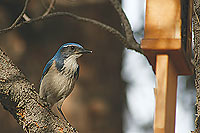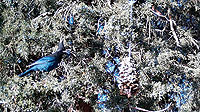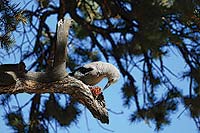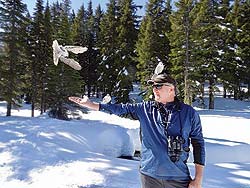In late winter, there is a group of birds that represents the hardiness of desert dwellers: The Jays. Raucous members of the Crow Family or Corvidae, several species are well represented here in Canyon Country.
 Starting from the canyons and lower elevational habitats including desert shrub and pinyon-juniper woodlands, the noisy Western scrub-jay bustles about. Often solitary or in small groups, these jays sport a bluish back with gray shoulders and a lightly-colored underside. Their boisterous nature often betrays their presence, stealth is not in their vocabulary.
Starting from the canyons and lower elevational habitats including desert shrub and pinyon-juniper woodlands, the noisy Western scrub-jay bustles about. Often solitary or in small groups, these jays sport a bluish back with gray shoulders and a lightly-colored underside. Their boisterous nature often betrays their presence, stealth is not in their vocabulary.
These jays are omnivores, often viewed raiding backyard bird feeding stations or preying on the eggs or nestlings of other birds. The “scrubs” consume berries, nuts, acorns, even the tick off a deer’s back. Set out a ring of unshelled peanuts and the birds will appear from unseen quarters; their talent for slipping peanuts from a wire wreath ring would make any jewelry thief jealous.
 Unlike their neighboring cousins, the pinyon jay prefers to congregate in large flocks that seem to be in constant communication unless a predatory hawk is nearby. The birds hunt for their preferred food: pinyon nuts, often caching seeds for future consumption. To us, the seed storage site selection may seem random, but not so to the GPS-wired jays. Their ability to remember cache locations is uncanny and, in a pinch, will switch over to ponderosa or Jeffrey pine seeds during years of low pinyon nut production.
Unlike their neighboring cousins, the pinyon jay prefers to congregate in large flocks that seem to be in constant communication unless a predatory hawk is nearby. The birds hunt for their preferred food: pinyon nuts, often caching seeds for future consumption. To us, the seed storage site selection may seem random, but not so to the GPS-wired jays. Their ability to remember cache locations is uncanny and, in a pinch, will switch over to ponderosa or Jeffrey pine seeds during years of low pinyon nut production.
 During the spring, the young fledgling “pinyons” gather together in groups called crèches – sort of an avian nursery where the young are watched over while their parents forage. When the adults return, from foraging on pinyon seeds, insects, spiders, and even small lizards, they feed their own young out of the feathered chaos.
During the spring, the young fledgling “pinyons” gather together in groups called crèches – sort of an avian nursery where the young are watched over while their parents forage. When the adults return, from foraging on pinyon seeds, insects, spiders, and even small lizards, they feed their own young out of the feathered chaos.
One of my favorite jays, the Steller’s jay, is a cool mimic (their red-tailed hawk scream imitation is spot on) and is named for a very astute German zoologist, physician, and explorer named Georg Steller (1709-1746) who served on the ill-fated Bering Expedition in 1741-42. Beset by problems, the expedition spent literally about 10 hours on North American soil, enough time to take on freshwater for the return trip home. During his brief time ashore, Steller collected numerous plants and animals new to science. One of them, a dark-crested jay, would eventually be named in his honor: the Steller’s jay.
 Moving up in elevation into the La Sals and the Abajos, one may encounter Canada jays, also known as camp robbers or gray jays. Not known for kicking over tents or toppling tables, these birds lose their fear of humans pretty quickly if food is left lying about. With grayish backs and white undersides, these fearless flyers swoop in to swipe or steal any unsuspecting winter enthusiast’s tasty treat.
Moving up in elevation into the La Sals and the Abajos, one may encounter Canada jays, also known as camp robbers or gray jays. Not known for kicking over tents or toppling tables, these birds lose their fear of humans pretty quickly if food is left lying about. With grayish backs and white undersides, these fearless flyers swoop in to swipe or steal any unsuspecting winter enthusiast’s tasty treat.
Another higher elevation jay-relative is the Clark’s nutcracker which initiates breeding in March or April, often when snow is still present. Known for their seed-caching and relocating abilities, these birds have excellent memories.
All five of these Corvid Family relatives which call Canyon Country home, share the trait of powerful, “all purpose” bills and a gregarious manner. They aren’t afraid to scold some sleeping owl or harass an outdoor cat. So be on the lookout for these raucous relatives during the 24th annual Great Backyard Bird Count, held February 12-15, 2021. Good birding and “enJAY” their antics!
 Starting from the canyons and lower elevational habitats including desert shrub and pinyon-juniper woodlands, the noisy Western scrub-jay bustles about. Often solitary or in small groups, these jays sport a bluish back with gray shoulders and a lightly-colored underside. Their boisterous nature often betrays their presence, stealth is not in their vocabulary.
Starting from the canyons and lower elevational habitats including desert shrub and pinyon-juniper woodlands, the noisy Western scrub-jay bustles about. Often solitary or in small groups, these jays sport a bluish back with gray shoulders and a lightly-colored underside. Their boisterous nature often betrays their presence, stealth is not in their vocabulary. Unlike their neighboring cousins, the pinyon jay prefers to congregate in large flocks that seem to be in constant communication unless a predatory hawk is nearby. The birds hunt for their preferred food: pinyon nuts, often caching seeds for future consumption. To us, the seed storage site selection may seem random, but not so to the GPS-wired jays. Their ability to remember cache locations is uncanny and, in a pinch, will switch over to ponderosa or Jeffrey pine seeds during years of low pinyon nut production.
Unlike their neighboring cousins, the pinyon jay prefers to congregate in large flocks that seem to be in constant communication unless a predatory hawk is nearby. The birds hunt for their preferred food: pinyon nuts, often caching seeds for future consumption. To us, the seed storage site selection may seem random, but not so to the GPS-wired jays. Their ability to remember cache locations is uncanny and, in a pinch, will switch over to ponderosa or Jeffrey pine seeds during years of low pinyon nut production. During the spring, the young fledgling “pinyons” gather together in groups called crèches – sort of an avian nursery where the young are watched over while their parents forage. When the adults return, from foraging on pinyon seeds, insects, spiders, and even small lizards, they feed their own young out of the feathered chaos.
During the spring, the young fledgling “pinyons” gather together in groups called crèches – sort of an avian nursery where the young are watched over while their parents forage. When the adults return, from foraging on pinyon seeds, insects, spiders, and even small lizards, they feed their own young out of the feathered chaos. Moving up in elevation into the La Sals and the Abajos, one may encounter Canada jays, also known as camp robbers or gray jays. Not known for kicking over tents or toppling tables, these birds lose their fear of humans pretty quickly if food is left lying about. With grayish backs and white undersides, these fearless flyers swoop in to swipe or steal any unsuspecting winter enthusiast’s tasty treat.
Moving up in elevation into the La Sals and the Abajos, one may encounter Canada jays, also known as camp robbers or gray jays. Not known for kicking over tents or toppling tables, these birds lose their fear of humans pretty quickly if food is left lying about. With grayish backs and white undersides, these fearless flyers swoop in to swipe or steal any unsuspecting winter enthusiast’s tasty treat.